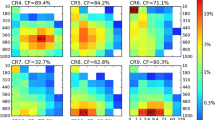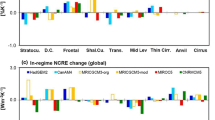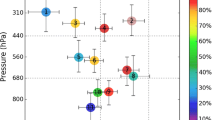Abstract
Differences in the radiative feedback from clouds account for much of the variation in climate sensitivity amongst General Circulation Models (GCMs). Therefore metrics of model performance which are demonstrated to be relevant to the cloud response to climate change form an important contribution to the overall evaluation of GCMs. In this paper we demonstrate an alternative method for assigning model data to observed cloud regimes obtained from clustering histograms of cloud amount in joint cloud optical depth—cloud top pressure classes. The method removes some of the subjectivity that exists in previous GCM cloud clustering studies. We apply the method to ten GCMs submitted to the Cloud Feedback Model Intercomparison Project (CFMIP), evaluate the simulated cloud regimes and analyse the climate change response in the context of these regimes. We also propose two cloud regime metrics, one of which is specifically targeted at assessing GCMs for the purpose of obtaining the global cloud radiative response to climate change. Most of the global variance in the cloud radiative response between GCMs is due to low clouds, with 47% arising from the stratocumulus regime and 18% due to the regime characterised by clouds undergoing transition from stratocumulus to cumulus. This result is found to be dominated by two structurally similar GCMs. The shallow cumulus regime, though widespread, has a smaller contribution and reduces the variance. For the stratocumulus and transition regimes, part of the variance results from a large model spread in the radiative properties of the regime in the control simulation. Comparison with observations reveals a systematic bias for both the stratocumulus and transition regimes to be overly reflective. If this bias was corrected with all other aspects of the response unchanged, the variance in the low cloud response would reduce. The response of some regimes with high cloud tops differ between the GCMs. These regimes are simulated too infrequently in a few of the models. If the frequency in the control simulation were more realistic and changes within the regimes were unaltered, the variance in the cloud radiative response from high-top clouds would increase. As a result, use of observations of the mean present-day cloud regimes suggests that whilst improvements in the simulation of the cloud regimes would impact the climate sensitivity, the inter-model variance may not reduce. When the cloud regime metric is calculated for the GCMs analysed here, only one model is on average consistent with observations within their uncertainty (and even this model is not consistent with the observations for all regimes), indicating scope for improvement in the simulation of cloud regimes.







Similar content being viewed by others
References
Anderberg MR (1973) Cluster analysis for applications. Academic Press, New York, 359 pp
Barkstrom BR, Harrison EF, Lee RB, Coauthors (1990) Earth radiation budget experiment (ERBE) archival and April 1985 results. Bull Am Meteorol Soc 70:1254–1262
Boer GJ, Yu B (2003) Climate sensitivity and response. Clim Dyn 20:415–429
Bony S, Dufresne JL (2005) Marine boundary layer clouds at the heart of cloud feedback uncertainties in climate models. Geophys Res Lett 32(20):L20806
Bony S, Dufresne JL, Le Treut H, Morcrette JJ, Senior CA (2004) On dynamic and thermodynamic components of cloud changes. Clim Dyn 22:71–86. doi:10.1007/s00382-003-0369-6
Cash BA, Schneider EK, Bengtsson L (2007) Origin of climate sensitivity differences: role of selected radiative parameterizations in two GCMs. Tellus 59:155–169. doi:10.1111/j.1600-0870.2006.00224.x
Cess RD, Potter GL, Blanchet JP, Boer GJ, Delgenio AD, Dequé M, Dymnikov V, Galin V, Gates WL, Ghan SJ, Kiehl JT, Lacis AA, Le Treut H, Li ZX, Liang XZ, McAveney BJ, Meleshko VP, Mitchell JFB, Morcrette JJ, Randall DA, Rikus L, Roeckner E, Royer JF, Shlese U, Sheinin DA, Slingo A, Sokolov AP, Taylor KE, Washington WM, Wetherald RT, Yagai I, Zhang MH (1990) Intercomparison and interpretation of climate feedback processes in 19 atmospheric general circulation models. J Geophys Res 95:16601–16615
Collins WD, Bitz CM, Blackmon ML, Bonan GB, Bretherton CS, Carton JA, Chang P, Doney SC, Hack JJ, Henderson TB, Kiehl JT, Large WG, McKenna DS, Santer BD, Smith RD (2006) The Community Climate System Model version 3 (CCSM3). J Clim 19(11):2122–2143
Delworth TL, Rosati A, Stouffer RJ, Dixon KW, Dunne J, Findell K, Ginoux P, Gnanadesikan A, Gordon CT, Griffies SM, Gudgel R, Harrison MJ, Held IM, Hemler RS, Horowitz LW, Klein SA, Knutson TR, Lin SJ, Milly PCD, Ramaswamy V, Schwarzkopf MD, Sirutis JJ, Stern WF, Spelman MJ, Winton M, Wittenberg AT, Wyman B (2006) GFDL’s CM2 global coupled climate models. Part 1: Formulation and simulation characteristics. J Clim 19(5):643–674
Gleckler PJ, Taylor KE, Doutriaux C (2008) Performance metrics for climate models. J Geophys Res 113. doi:10.1029/2007JD008972
Gordon ND, Norris JR, Weaver CP, Klein SA (2005) Cluster analysis of cloud regimes and characteristic dynamics of midlatitude synoptic systems in observations and a model. J Geophys Res 110. doi:10.1029/2004JD005027
Jakob C, Tselioudis G (2003) Objective identification of cloud regimes in the Tropical Western Pacific. Geophys Res Lett 30(21). doi:10.1029/2003GL018367
K-1 Model Developers (2004) K-1 coupled model (MIROC) description. K−1 technical report 1. H Hasumi H, Emori S (eds), Center for Climate System Research, University of Tokyo, Tokyo
King MD, Menzel WP, Kaufman YJ, Tanre D, Gao BC, Platnick S, Ackerman SA, Remer LA, Pincus R, Hubanks PA (2003) Cloud and aerosol properties, precipitable water, and profiles of temperature and humidity from MODIS. IEEE T Geosci Remote 41:442–458
Klein SA, Jakob C (1999) Validation and sensitivities of frontal clouds simulated by the ECMWF model. Mon Weather Rev 127(10):2514–2531
Mace GG, Benson S, Sonntag KL, Kato S, Min Q, Minnis P, Twohy CH, Poellot M, Dong X, Long C, Zhang Q, Doelling DR (2006) Cloud radiative forcing at the atmospheric radiation measurement programme climate research facility: 1. Technique, validation, and comparison to satellite-derived diagnostic quantities. J Geophys Res 111. doi:10.1029/2005JD005921.
Martin GM, Co-authors (2008) Analysis and reduction of climate model systematic errors through a unified modelling strategy (in preparation)
Martin GM, Ringer MA, Pope VD, Jones A, Dearden C, Hinton TJ (2006) The physical properties of the atmosphere in the new Hadley Centre Global Environmental Model (HadGEM1). Part I: model description and global climatology. J Clim 19:1274–1301. doi:10.1175/JCLI3636.1
McAvaney BJ, Le Treut H (2003) The cloud feedback intercomparison project: (CFMIP). In: CLIVAR exchanges—supplementary contributions. 26 March
Medeiros B, Stevens B, Held IM, Zhao M, Williamson DL, Olson JG, Bretherton CS (2008) Aquaplanets, climate sensitivity, and low clouds. J Clim. doi:10.1175/2008JCLI1995.1 (in press)
Murphy JM, Sexton DMH, Barnett DN, Jones GS, Webb MJ, Collins M, Stainforth DA (2004) Quantification of modelling uncertainties in a large ensemble of climate change simulations. Nature 430:768–772
Norris JR, Weaver CP (2001) Improved techniques for evaluating GCM cloudiness applied to the NCAR CCM3. J Clim 14:2540–2550
Ogura T, Emori S, Webb MJ, Tsushima Y, Yokohata T, Abe-Ouchi A, Kimoto M (2008) Towards understanding cloud response in atmospheric GCMs: the use of tendency diagnostics. J Meteorol Soc Jpn 86(1):69–79
Pincus R, Batstone CP, Patrick-Hofmann RJ, Taylor KE, Gleckler PE (2008) Evaluating the present-day simulation of clouds, precipitation and radiation in climate models. J Geophys Res (in press)
Pope VD, Gallani ML, Rowntree PR, Stratton RA (2000) The impact of new physical parametrizations in the Hadley Centre climate model—HadAM3. Clim Dyn 16:123–146
Reichler T, Kim J (2008) How well do coupled models simulate today’s climate? Bull Am Meteorol Soc 89(3):303–311. doi:10.1175/BAMS-89-3-303
Ringer MA, McAvaney B, Andronova N, Buja L, Esch M, Ingram W, Li B, Quaas J, Roeckner E, Senior C, Soden B, Volodin E, Webb M, Williams K (2006) Global mean cloud feedbacks in idealized climate change experiments. Geophys Res Lett 33:L07718. doi:10.1029/2005GL025370.
Roeckner E, Bauml G, Bonaventura L, Brokopf R, Esch M, Giorgetta M, Hagemann S, Kirchner I, Kornblueh L, Manzini E, Rhodin A, Schlese U, Schulzweida U, Tompkins A (2003) The atmospheric general circulation model ECHAM 5. Part I: model description. Technical Report 349, Max Planck Institute for Meteorology
Rossow WB, Schiffer RA (1999) Advances in understanding clouds from ISCCP. Bull Am Meteorol Soc 80:2261–2287
Rossow WB, Walker AW, Beuschel DE, Roiter MD (1996) International Satellite Cloud Climatology Project (ISCCP) documentation of new cloud datasets. WMO/TD 737, World Meteorological Organisation, 115 pp
Rossow WB, Tselioudis G, Polak A, Jakob C (2005) Tropical climate described as a distribution of weather states indicated by distinct mesoscale cloud property mixtures. Geophys Res Lett 32(21). doi:10.1029/2005GL024584
von Salzen K, McFarlane NA, Lazare M (2005) The role of shallow convection in the water and energy cycles of the atmosphere. Clim Dyn 25:671–688. doi:10.1007/s00382-005-0051-2
Senior CA, Mitchell JFB (1993) Carbon dioxide and climate: the impact of cloud parameterization. J Clim 6:393–418
Soden BJ, Held IM (2006) An assessment of climate feedbacks in coupled ocean–atmosphere models. J Clim 19:3354–3360
Soden BJ, Broccoli AJ, Hemler RS (2004) On the use of cloud forcing to estimate cloud feedback. J Clim 17(19):3661–3665. doi:10.1175/1520-0442(2004)017
Tselioudis G, Zhang Y, Rossow WB (2000) Cloud and radiation variations associated with northern midlatitude low and high sea level pressure regimes. J Clim 13(2):312–327
Wang J, Rossow WB, Uttal T, Rozendaal M (1999) Variability of cloud vertical structure during ASTEX observed from a combination of rawinsonde, radar, ceilometer, and satellite. Mon Weather Rev 127(10):2484–2502
Webb M, Senior C, Bony S, Morcrette JJ (2001) Combining ERBE and ISCCP data to assess clouds in the Hadley Centre, ECMWF and LMD atmospheric climate models. Clim Dyn 17:905–922
Webb MJ, Senior CA, Sexton DMH, Ingram WJ, Williams KD, Ringer MA, McAvaney BJ, Colman R, Soden BJ, Gudgel R, Knutson T, Emori S, Ogura T, Tsushima Y, Andronova NG, Li B, Musat I, Bony S, Taylor KE (2006) On the contribution of local feedback mechanisms to the range of climate sensitivity in two GCM ensembles. Clim Dyn 27(1):17–38. doi:10.1007/s00382-006-0111-2
Williams KD, Tselioudis G (2007) GCM intercomparison of global cloud regimes: present-day evaluation and climate change response. Clim Dyn 29:231–250. doi:10.1007/s00382-007-0232-2
Williams KD, Ringer MA, Senior CA, Webb MJ, McAvaney BJ, Andronova N, Bony S, Dufresne JL, Emori S, Gudgel R, Knutson T, Li B, Lo K, Musat I, Wegner J, Slingo A, Mitchell JFB (2006) Evaluation of a component of the cloud response to climate change in an intercomparison of climate models. Clim Dyn 26:145–165. doi:10.1007/s00382-005-0067-7
Winker DM, Hunt WH, McGill MJ (2007) Initial performance assessment of CALIOP. Geophys Res Lett 34:L19803. doi:10.1029/2007GL030135
Zhang Y, Rossow WB, Lacis AA, Oinas V, Mishchenko MI (2004) Calculation of radiative fluxes from the surface to top of atmosphere based on ISCCP and other global data sets: Refinements of the radiative transfer model and input data. J Geophys Res 109(D19,105). doi:10.1029/2003JD004457
Zhang Y, Klein S, Mace GG, Boyle J (2007) Cluster analysis of tropical clouds using cloudsat data. Geophys Res Lett 34:L12813. doi:10.1029/2007GL029336
Acknowledgments
This work was supported by the Joint Defra and MoD Programme (Defra) GA01101 (MoD) CBC/2B/0417_Annex C5. We thank Robert Pincus for providing the MODIS data and useful conversations around developing the CREMs. We also thank Alejandro Bodas-Salcedo, Philip Brohan, William Ingram and Mark Ringer for their comments on early drafts of the paper. We acknowledge the modelling groups for making their simulations available for analysis, PCMDI for collecting and archiving the CMIP3 and CFMIP model output, and the WCRP’s Working Group on Coupled Modelling (WGCM) for organising the model data analysis activity. The WCRP CMIP3 and CFMIP multi-model datasets are supported by the Office of Science, US Department of Energy. ISCCP and ERBE data were obtained from the NASA Langley Research Center Atmospheric Sciences Data Center.
Author information
Authors and Affiliations
Corresponding author
Electronic Supplementary Material
Rights and permissions
About this article
Cite this article
Williams, K.D., Webb, M.J. A quantitative performance assessment of cloud regimes in climate models. Clim Dyn 33, 141–157 (2009). https://doi.org/10.1007/s00382-008-0443-1
Received:
Accepted:
Published:
Issue Date:
DOI: https://doi.org/10.1007/s00382-008-0443-1




